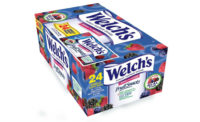Fruits and nuts. Seems artisan as well as mainstream confectioners can’t get enough of them. Be it pistachios, almonds, walnuts, hazelnuts, berries (of all kinds), apples, oranges, the list goes on. This year it appears that pistachios —in particular — have their time in the sun to shine as a trendy inclusion amongst a broad range of artisanal chocolatiers.
A quick Google search of the nut brought several hits: First, there’s Ethereal Chocolate’s Chocolate Bar – Pistachios + Cranberries + Sea Salt. It’s a 66% organic dark chocolate married with crunchy pistachios, the fruity sweetness of dried cranberries and the added bonus of flakes of fleur de sel.
How about a truly classic confection, like Norman Love’s Pistachio Nougat Bar? Who can resist a whipped honey and pistachio nougat folded into sun-dried cherries, almonds, hazelnuts and pistachios, and then topped with a thin layer of Swiss white chocolate?
Of course, there’s the more exotic Indian Curry & Pistachio brittle offering from Morning Glory Confections. It brings the exotic flavors of coriander, turmeric, fenugreek and other traditional Indian spices together with the complex taste of fresh pistachios for a brittle that is both spicy and subtle.
Even Lindt has jumped on the bandwagon with its newly introduced Cranberry Pistachio Bark. So why the rage for pistachios lately?
“Pistachios are delicious and pretty,” explains Stephen Durfee, pastry chef-instructor at the Culinary Institute of America at Greystone. “They add diversity and a layer of luxury compared to other nuts.”
He uses pistachios frequently in confections and chocolates. In those applications, Durfee considers the nuts interchangeable with almonds, hazelnuts, or walnuts. “If a confectionery recipe works for one type, I assume that I can use another,” says the chef. “It opens up all kinds of versatility.”
Naturally, pistachios, however trendy, represent only one component of the fruit-and-nut ingredient storehouse. Consider Recchiuti Confections’ Orchard bar, inspired by the chocolatier’s fondness for currants paired with chocolate. Dark fruit-flavored currants, earthy mulberries and toasted almond pieces, coated in burnt caramel syrup and sea salt, are added to a custom Semisweet Chocolate. Tantalizing texture ensues.
And Lindt didn’t just go with pistachios for its new line of bark; it’s offering Milk Chocolate Blueberry and Dark Chocolate Almond Bark varieties as well.
Naturally, there’s a strong health benefit associated with fruits and nuts, a draw that’s important for many consumers. Some stats from the Almond Board of California (ABC) underscore that perception.
During a recent five-year period (2007 – 2011), confectionery product introductions with almonds jumped an impressive 113 percent. Additionally, 33 percent of the global almond introductions in 2012 occurred in the confectionery category.
|
Nuts continue to score high on health
Once again, ongoing research continues to reveal the benefits of eating tree nuts. A new study, published in early January 2014 in the online journal PLOS ONE and funded by the International Tree Nut Council Nutrition Research and Education Foundation, found that consumers who eat tree nuts (almonds, Brazil nuts, cashews, hazelnuts, macadamias, pecans, pine nuts, pistachios and walnuts) were less likely to be obese than non-consumers. The study looked at the association between tree nuts, metabolic syndrome (MetS) and obesity in a population with a wide range of nut intake ranging from never to daily. Researchers at Loma Linda University studied 803 Seventh-day Adventist adults using a validated food frequency questionnaire and assessed both tree nut and peanut intake together and separately. Mean tree nut intake was 16 grams/day among the high tree nut consumers and 5 grams/day among low tree nut consumers. “Our results showed that one serving (28 g or 1 ounce) of tree nuts per week was significantly associated with 7 percent less MetS,” stated lead researcher Karen Jaceldo-Siegl. “Doubling this consumption could potentially reduce MetS risk by 14 percent” She added, “Interestingly, while overall nut consumption was associated with lower prevalence of MetS, tree nuts specifically appear to provide beneficial effects on MetS, independent of demographic, lifestyle and other dietary factors.” MetS is a cluster of risk factors shown to be associated with death, a twofold increased risk for cardiovascular disease, and a fivefold increased risk for type 2 diabetes. While the diagnostic criteria can vary, the presence of any three of the five following conditions results in a diagnosis of MetS: abdominal obesity, elevated triglycerides, low HDL cholesterol (the good cholesterol), high blood pressure, and hyperglycemia (high blood sugar levels). Based on NHANES data from 2003-2006, an estimated 34.3 percent of the U.S. population has MetS. In addition to the effect of nuts on MetS, the researchers also looked at the effect on obesity. “We found that high tree nut consumers had significantly lower prevalence of obesity compared to the low tree nut consumers,” explains Dr. Jaceldo-Siegl. |
That’s not all. Twenty-nine percent of all chocolate consumption occasions around the world included almonds — a significant percentage considering the variety of products and ingredients consumed across countries and cultures.
What does this mean for manufacturers? Kate Thomson, director, Insights and Strategy for Sterling-Rice Group, believes the implications for production are strong and growing. “Manufacturers that are including almonds in their chocolate products can be confident they are already developing to meet consumer demand for this flavorful, nutty combination,” she says. “Looking forward, if current consumer preferences are any indication of future predilections, demand for almonds and chocolate will continue to spur product innovation as manufacturers develop new ways to offer this tried-and-true pairing.”
“I think consumers want both — healthy and indulgent,” adds Bill Morecraft, general manager, Blue Diamond Almonds Global Ingredients Division. “The great thing about almonds is that they have the healthy halo of their superior nutritional profile while offering taste and texture that fulfills on the side of indulgence. The health benefits of almonds are undeniable, since they’re packed with high amounts of protein, fiber, vitamin E, calcium and other minerals. On the indulgence side, almonds are an excellent flavor carrier and we’ve been adding flavors like coconut, orange, honey and many others. The flavor and texture of almonds can therefore provide the decadent taste consumers crave along with the nutritional value they look for.”
Still, it’s important to realize that there’s a subtle nuance involving health and hedonism when it comes to using fruits and nuts. As Morecraft explains, “The continued news about almonds’ health benefits has not necessarily boosted use by confectioners, but we see them calling out almonds more on packaging. By promoting a product as one that has almonds, a manufacturer is able to attract consumers looking for something that is indulgent and still healthy. We are seeing confectioners taking the time to differentiate their products that contain almonds with packaging that calls out this ingredient.”
Again, the broad variety of fruit and nut ingredients provides confectioners and manufacturers with plenty of options to enhance their confections with healthy benefits, textural variety, flavor fusion and simply elegant detail.
But it’s not only flavors confectioners and confectionery manufacturers are looking at, it’s also the variety of nut and fruit formats available that make these ingredients a favorite. Bruce Kotz, v.p. – specialty products for Golden Peanut Co. LLC, points out that partially defatted peanut flour is selling very well in the confections segment.
“We are seeing many nutritional bars incorporate peanut flour for its strong roasted flavor and its high protein level in the layer portion of the bar,” he says. “As you know, plant proteins are a very hot trend right now so we are seeing more and more companies evaluating and buying peanut flour, which is the most efficient way to get peanut protein. In addition we are seeing several snack and breakfast bars utilizing peanut butter flavored coatings that utilize peanut flour for the flavor and color.”
But even when confectioners resort to using only one nut or fruit, the results can be creative. For example, Morecraft points out that some chocolate bar products use almond paste to provide a certain desired consistency in a chocolate, after which the same bar uses diced almonds to provide a crunchy texture.
Of course, Michael Recchuitti’s chocolate-enrobed Key Lime Apples and Pears reflect simplicity and yet sensational taste and texture. Classic, yet so cool.









